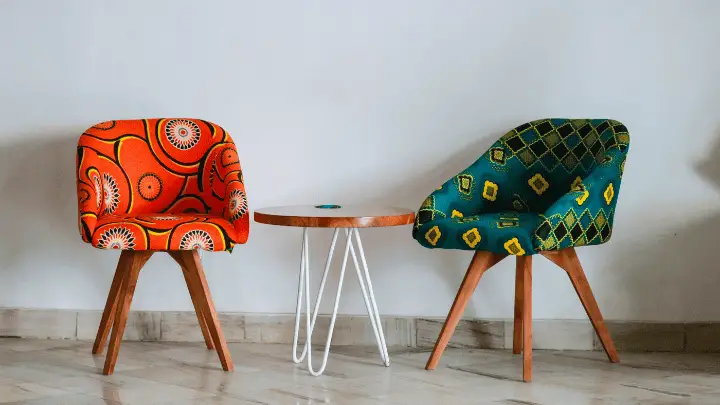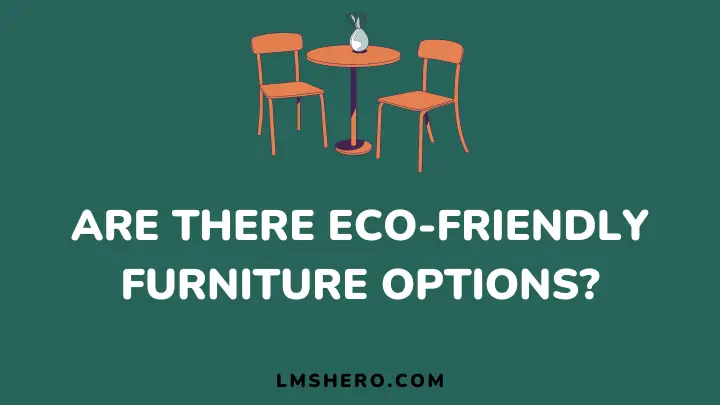Eco-friendly furniture is furniture that is made from materials that have a low environmental impact, such as recycled, reclaimed, or renewable sources. Eco-friendly furniture options can also include furniture that is designed to last longer, use less energy, or reduce waste.
Why should you care about eco-friendly furniture? Because it can help you create a more sustainable and healthy living space while also supporting the planet and its resources. In this article, you will discover some of the benefits and misconceptions of eco-friendly furniture.
You’ll also explore some of the best material options available on the market. Whether you are looking for a new sofa, a dining table, or a bookshelf, you will find some inspiring ideas to make your home more green and stylish.
Let’s get started.
Benefits of Eco-Friendly Furniture
- It helps to conserve natural resources and prevent deforestation by using materials that are renewable, recycled, or reclaimed. For example, bamboo is a fast-growing plant that can be harvested without harming the ecosystem. Also, reclaimed wood is wood that has been salvaged from old buildings or furniture.
- It reduces waste and pollution by avoiding materials that are toxic, non-biodegradable, or single-use. Eco-friendly furniture, for example, uses non-toxic paints, varnishes, and fabrics that emit no harmful chemicals into the environment. Additionally, eco-friendly furniture avoids plastic and metal, which can take centuries to biodegrade.
- It creates a healthy and harmonious home by improving the indoor air quality and the aesthetic appeal of the space. For example, eco-friendly furniture does not release volatile organic compounds (VOCs) that can cause headaches, allergies, or respiratory problems. These eco-friendly options often have a natural, organic, or rustic look that adds warmth and character to the home.
- It supports local economies and social causes by buying from small businesses, artisans, or fair trade organizations that produce eco-friendly furniture. Eco-friendly furniture can be made by local craftsmen who use traditional techniques and local materials. It can also be made by cooperatives that provide fair wages and working conditions to their workers.
- It saves money and energy by being durable, low-maintenance, and energy-efficient. For example, eco-friendly furniture is often made from high-quality materials that last longer and require less repair or replacement. It can also help to reduce heating or cooling costs by using materials that are good insulators, such as bamboo or cotton.
What Eco-Friendly Furniture Materials Should You Get

As I stated earlier, eco-friendly furniture materials are those that have a low environmental impact and can be recycled or reused. Some of the most popular eco-friendly furniture materials are:
1. Reclaimed wood
This is wood that has been salvaged from old buildings, furniture, or other sources and given a new life. Reclaimed wood reduces the need for cutting down new trees and preserves the natural beauty and history of the wood.
2. Bamboo
This is a fast-growing grass that can be harvested repeatedly without harming the soil or the ecosystem. Bamboo is durable, lightweight, and versatile. It can be used to make furniture frames, panels, or flooring.
3. Certified sustainable wood
This is wood that comes from forests that are managed responsibly and follow the standards of environmental and social sustainability. Certified sustainable wood ensures that forest resources are conserved and the rights of the local communities are respected.
4. Sustainable fabrics
These are fabrics that are made from natural or recycled materials, such as organic cotton, hemp, linen, or wool. Sustainable fabrics are biodegradable, breathable, and comfortable. They can be used to make furniture upholstery, cushions, or curtains.
Important Qualities of Eco-Friendly Furniture
1. Durability and easily fixable
Furniture that lasts longer and can be repaired easily reduces the need for frequent replacement and disposal, which saves resources and reduces waste. Durable furniture also tends to be made of higher-quality materials that are less likely to break or degrade over time.
2. Recycled and upcycled materials
Furniture that is made of upcycled or recycled materials reduces the demand for new raw materials. This also prevents useful materials from ending up in landfills, such as reclaimed wood, metal, plastic, or fabric.
Recycled and upcycled furniture also gives a new life and purpose to old or discarded items, which can create unique and creative designs.
3. Low-Toxicity
Furniture that is low in toxicity means that it does not emit harmful chemicals or gases into the air, such as volatile organic compounds (VOCs), formaldehyde, or flame retardants.
These substances can cause health problems such as headaches, allergies, asthma, or cancer. Low-toxicity furniture also uses natural or organic finishes, paints, glues, or fabrics that are safer for the environment and human health.
4. Flexible and Small
Furniture that is flexible and small means that it can adapt to different spaces and needs, such as multifunctional furniture, modular furniture, or foldable furniture.
This type of furniture can save space and energy, as well as offer convenience and versatility. Flexible and small furniture also reduces the amount of furniture needed, which lowers the environmental footprint of production and transportation.
5. Certification
Furniture that has certification means that it meets certain standards or criteria for environmental and social responsibility, such as the Forest Stewardship Council (FSC), the Global Organic Textile Standard (GOTS), or the Cradle to Cradle Certified Product Standard.
These certifications ensure that the furniture is made of sustainable materials, has a low impact on the environment, supports fair labor practices, and promotes circular economy principles.
Tips To Shop for Eco-Friendly Furniture
1. Buy local
Buying furniture from local artisans or shops can reduce the environmental impact of transportation and packaging. It can also support the local economy and community. Local furniture may also use more natural and sustainable materials, such as wood, bamboo, or rattan.
2. Buy vintage
Buying vintage or second-hand furniture can prevent waste and save resources. Vintage furniture can also add character and charm to your home.
You can find vintage furniture in thrift stores, flea markets, online platforms, or auctions. Make sure to check the quality and condition of the furniture before buying it.
3. Avoid flame retardants
Flame retardants are chemicals that are added to furniture fabrics and foams to make them less flammable. However, they can also pose health and environmental risks, such as cancer, hormone disruption, and air pollution.
Flame retardants can leach out of furniture and contaminate your indoor air and dust. To avoid them, look for furniture that is labeled as “flame retardant free” or “TB 117-2013 compliant”.
4. Research brands and manufacturers
Before buying furniture, do some research on the brands and manufacturers that you are considering. Look for information on their environmental policies, practices, certifications, and impact.
You can also check customer reviews and ratings to see how satisfied they are with the quality and durability of the furniture. Some websites and apps can help you compare different brands and products based on their environmental performance.
5. Understanding the lifecycle of furniture products
Furniture products have different stages in their lifecycle, from raw material extraction to production, distribution, use, and disposal. Each stage can have different environmental impacts, such as greenhouse gas emissions, water consumption, waste generation, and biodiversity loss.
To choose eco-friendly furniture, you should consider the whole lifecycle of the product and how you can minimize its negative impacts. Choosing furniture that is made of renewable or recycled materials is an option.
Choose furniture that can be repaired or reused or furniture that can be recycled or composted after it is no longer needed.
Popular Misconceptions about Eco-Friendly Furniture
Despite the numerous benefits, misconceptions about eco-friendly furniture persist, hindering its widespread adoption.
1. Affordability
It is commonly believed that eco-friendly options come with a high price tag. But the truth is that the market now offers a diverse range of sustainable choices that are affordable for everyone.
Due to the growing demand for eco-friendly furniture, manufacturers have been forced to reduce their prices, making sustainable options accessible to a wider audience.
Thus, environmentally conscious consumers now have a variety of affordable options without compromising on quality or style.
2. Limited style options
The idea that environmentally friendly furniture is unattractive and lacks style is a common misconception that is no longer true. Nowadays, designers are more conscious of the impact their furniture has on the environment.
They are creating diverse, aesthetically pleasing pieces that appeal to various tastes while adhering to eco-friendly principles. Sustainable furniture is no longer limited to a particular style or aesthetic.
Rather, it encompasses a broad range of designs that cater to different preferences. Moreover, sustainable furniture is often made using materials that are renewable, biodegradable, or recycled, further reducing its environmental impact.
3. Durability concerns
It’s important to remember that eco-friendly furniture doesn’t necessarily mean sacrificing durability or strength. In fact, many sustainable materials, such as bamboo and recycled metal, offer comparable or even superior durability to traditional options like wood or plastic.
This means that not only can eco-friendly furniture be designed to last just as long as conventional pieces. But it can also provide added benefits like resistance to wear and tear, extreme weather conditions, and even pests like termites.
So, if you’re considering making the switch to more sustainable furniture options, don’t hesitate to explore the many long-lasting and durable materials that are available today.
Future Trends in Eco-Friendly Furniture

As environmental consciousness grows, the future of eco-friendly furniture holds exciting developments.
Technological innovations
Advancements in technology will likely lead to more sustainable manufacturing processes and innovative materials, further reducing the environmental impact of furniture production.
Circular economy practices
The adoption of circular economy practices in the furniture industry is on the rise. This involves designing products with a focus on longevity, repairability, and recyclability, creating a more sustainable product lifecycle.
Increasing popularity
The rising awareness of environmental issues is driving the popularity of eco-friendly furniture. As more consumers prioritize sustainability, the market for eco-conscious options is expected to expand.
FAQs
Are eco-friendly furniture options more expensive?
No. The market now offers affordable, sustainable choices, making eco-friendly furniture accessible to a broader audience.
Do sustainable furniture pieces lack style?
No. Contemporary designers create diverse, aesthetically pleasing pieces that cater to various tastes while adhering to eco-friendly principles.
Is eco-friendly furniture less durable than traditional options?
No. Many sustainable materials, such as bamboo and recycled metal, offer durability comparable to traditional options, ensuring longevity.
What certifications indicate eco-friendly furniture?
Look for certifications like FSC (Forest Stewardship Council) for wood products or OEKO-TEX for textiles, validating specific environmental and health standards.
Can you create eco-friendly furniture at home?
Yes. Through upcycling old furniture, creating pallet furniture, and using eco-friendly paints and finishes in DIY projects.
How can you incorporate eco-friendly furniture into a small space?
Opt for multi-functional and compact designs that contribute to sustainable living without sacrificing style or comfort.
Wrapping Up
Eco-friendly furniture is not only good for the environment, but also for your health and well-being. By choosing furniture made from natural, renewable, or recycled materials, you can reduce your carbon footprint, avoid harmful chemicals, and support ethical and sustainable practices.
Eco-friendly furniture can also be stylish, comfortable, and affordable, as there are many options available in the market today. Regardless of your wants and preferences, you can find eco-friendly furniture that suits your taste and budget.
You can also DIY your own furniture from reclaimed wood, pallets, or other materials, or upcycle your old furniture with some paint and creativity. The possibilities are endless!
I hope this article has inspired you to explore eco-friendly furniture options for your home or office. Remember, every small choice you make can have a big impact on the planet and your future.
You can also learn more about how architects incorporate sustainability into their designs.
Thanks for reading.

